Avegant Glyph: The big screen that you wear on your face (but it’s not VR)
You’ve probably heard plenty about all the virtual-reality (VR) headsets that will be weighing down nerdy heads later this year: Very expensive goggles that you can put on and, by turning your head, look around inside your video games.
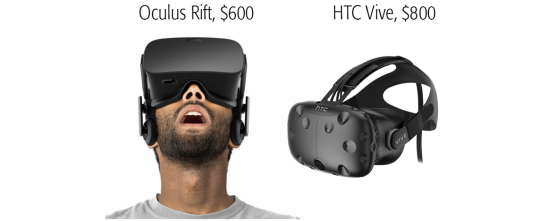
The subject of today’s lesson, however, is not a VR headset.
It’s the Avegant Glyph ($700), the finished 1.0 version of a successful Kickstarter campaign, which I reviewed in its prototype form two years ago. (The company’s name is constructed from the founders’ last names spelled backwards: Edward Tang and Allan Evans.)
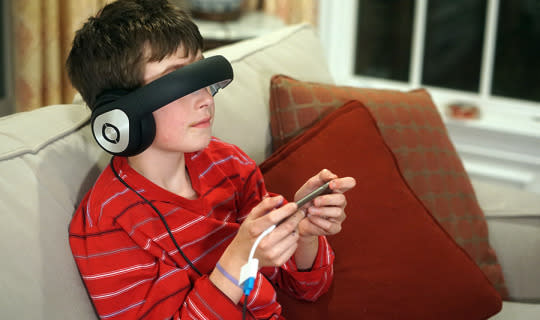
The idea is sweet: Imagine a pair of great-sounding headphones whose headband rotates down over your eyes to become a 65-inch TV screen floating in space right in front of you. Suddenly, you’ve got a whole darkened movie theater all to yourself.
What you see looks something like this:
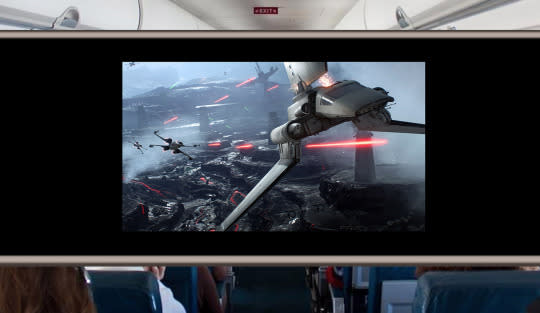
You can watch movies, TV shows, and games, or even work on your laptop using this “screen” as your monitor. The whole idea is to let you watch things in private, whether at home or on long plane flights.
(And what kind of things would you want to watch in private? The company winkingly mentions the nudity in Game of Thrones, but we all know what kind of videos they’re really talking about.)
Getting ready to Glyph
The Glyph really is a contraption. It weighs about a pound, so figuring out how to hang that thing on your head comfortably for hours is a challenge that Avegant hasn’t completely solved.
First, you choose a nose piece — one of four snap-in, rubberized bridges to accommodate a range of nasal formations.
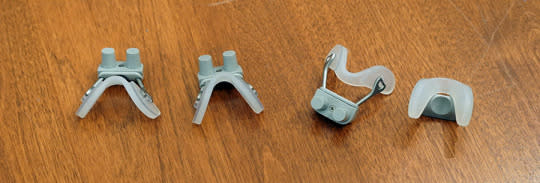
Then you put the Glyph on and press an ejecto-button to make the eyepieces pop out of the band.
Next you adjust the distance between the left and right eye holes, using two separate sliders. Then you have to focus each eyepiece independently, turning a ring around each eyepiece as you close the other eye.
Finally, if it feels too heavy on your head, you can attach a strap that goes over the top of your head. That, and a not-so-protective felt bag, are all part of the Founder’s Edition kit.
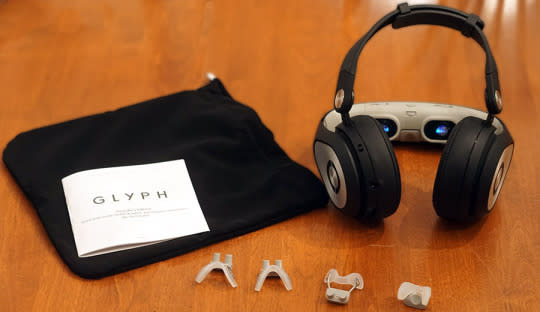
Let’s not beat around the bush: The thing looks ridiculous. You thought Google Glass drew stares? This thing makes you look like you’re a member of the Geordi La Forge Fan Club.
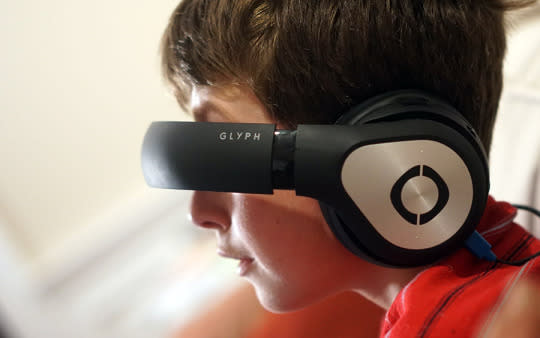
And even with all of that fussing, I was never able to make it comfortable to wear for a long time.
If you want to use Glyph just as a pair of headphones, it’s as easy as 1, 2, 3, 4, 5, 6, 7: Just retract the eye cups, pull out the nose piece, replace it with a flat spacer, wrap a comfort wrap around the headband (to prevent the hard plastic eyecup cylinders from penetrating your skull), adjust the headband, plug in an audio source, and listen away.
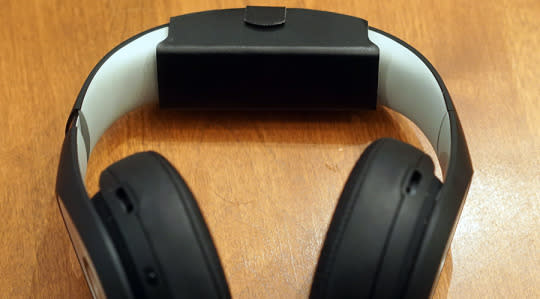
The sound from the big, cushy earcups is excellent. Unfortunately, these aren’t noise-canceling headphones, as originally promised.
The battery lasts for four hours of video, and charges from a USB cable. You can watch videos while it’s charging, which is nice. In headphone-only mode, no battery power is required.
Your personal theater
The beating heart of the Glyph is its “screenless screen,” which is designed to give the appearance of a 65-inch movie screen that’s 10 feet away. You feel as though you’re sitting in the exact center of a movie theater (with no big-headed person blocking part of your view).
Inside, Glyph has built a greatly miniaturized version of Texas Instruments’s DLP (digital light processing) system, like the one found in many home-theater and business projectors.
The Glyph screen doesn’t light up; it’s not built of glowing pixels, like VR goggles or the screens on phones, and laptops. Instead, low-power LED lights shine onto two million tiny, rotating mirrors (a million per eye). By twisting incredibly quickly, these mirrors control which red, blue, and green beams are bounced directly into your eyes.
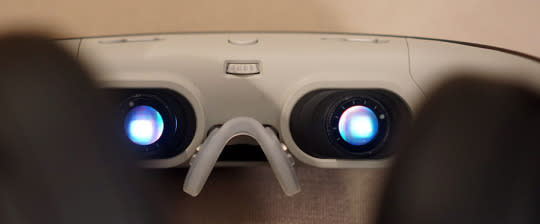
The advantages of this setup: The image is unbelievably bright, clear, and vivid. You don’t see any pixels at all.
And since your left and right eyes see different images, the Glyph is fantastic for 3-D movies and videos. No movie-theater or even home-theater glasses have ever done such justice to 3-D movies. (They must be “side-by-side” 3-D format. You can find a lot of them on YouTube by searching for “3D SBS 720p.”)
Unlike VR headsets, the Glyph doesn’t completely seal you off from the world; you can still see out, above or below the headband. In other words, you can still see the food on your airplane tray, still pick up your beverage, still see the flight attendant trying to get your attention.
The use cases
So what can you watch on the Glyph? Pretty much anything. Glyph doesn’t require specially prepared games or videos, as VR headsets do, and doesn’t have to be plugged into some monster PC. It’s basically just an external monitor for anything you can plug an HDMI cable into.
That would include the iPhone, iPad, laptops, Blu-ray players, and game consoles. (Some of these require an adapter, which is not included.) Alas, the Glyph compatibility list does not include the Samsung Galaxy S6, Galaxy S6 Edge, Galaxy Note 5, or Motorola Nexus 6.
OK, so they’ve built a great-looking screen into a visor. You’ve paid an unbelievable amount for it: $700. When would you actually use the thing?
Plane flights. This, really, is the killer app. Watch movies on planes that don’t offer in-flight entertainment. Entertain yourself for hours from videos on your phone, playing as big as a movie screen.
Car rides. Strap one of these onto your kid’s face in the back seat, hit Play on some Michael Bay movie, then drive on in quiet serenity.
Bed. Watch TV or movies, as bright and as loud as you want, without disturbing the sleeping person next to you.
Computer work. There are times when you might like to have your computer’s monitor strapped to your face, either for privacy or some ergonomic reason. The extreme corners of the monitor are hard to make out, because you naturally turn your eyes to look there, and now the curvature of the eyepiece is cutting off your vision; but it’s doable.
Console games. Because you can plug right into your console, you can be playing a game while someone else is watching the TV.
Phone games. Finally, you can play a game on your smartphone without your thumbs blocking the screen image.
Race drones. Some drones can transmit their camera’s-eye-view to a handheld controller. With the Glyph plugged in, you get a first-person view of the drone’s angle, which can be thrilling.
Daily activities. Remember, you can peek out at the world around you while you’re watching movies. So it’s conceivable (though not endorsed by Avegant or its lawyers) that you could entertain yourself while doing other things: mowing the lawn, washing dishes, folding laundry, or walking the dog.
VR. The Glyph is not a VR headset. But it does do some head tracking if you install something called the Jaunt VR player. At that point, you can experience a few VR “movies” and look around inside them.
The view from here
If some of those use cases seem just a little contrived or uncommon, well, you’re right. Most people find a demo of the Glyph to be very cool — but in practice, it’s heavy, bristling with too many parts and pieces, and uncomfortable.
Unfortunately, unless you fly frequently enough to qualify for Zirconium Elite status, it would be hard to justify paying $700 for these babies.
The “screenless screen” technology is a home run, though. So here’s hoping that Avegant hangs in there long enough to see its invention through to a lighter, less expensive Glyph 2.0.
David Pogue is the founder of Yahoo Tech; here’s how to get his columns by email. On the Web, he’s davidpogue.com. On Twitter, he’s @pogue. On email, he’s poguester@yahoo.com. He welcomes non-toxic comments in the Comments below.

